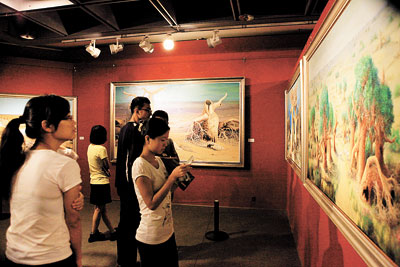
Wang Yuanyuan
cheekywang@hotmail.com
WELL-KNOWN painter, Liu Yong, is currently holding an exhibition of paintings about populus euphratica forest in the Xinjiang Uygur Autonomous Region at Shenzhen Museum in Futian District, until Oct. 27.
Liu, a professional painter from Sichuan Museum, has been living in Xinjiang for more than 50 years and has explored the Taklimakan Desert for more than 20 years. As a painter who loves wild and natural settings, the populus euphratica is his favorite plant and the source of his works.
In order to collect materials for his paintings, he has traveled across the desert and Ejina in Inner Mongolia where the largest number of populus euphratica forests are located.
The populus euphratica, commonly known as the eupharates poplar, is a species of poplar tree in the willow family. Known as the “living fossils,” the trees in the vicinity of the Tarim River are the oldest poplar trees in the world, emerging with the upheaval of the Qinghai-Tibet Plateau. This kind of poplar tree has existed for more than 60 million years. Fossils of this kind of poplar tree have been discovered in the strata of the Tertiary Oligocene located at Kuga Thousand-joss Cave and Dunhuang Balcksmith Grove. These fossils range from 3 to 6 million years old and have physiological traits that make them very hardy, enabling them to withstand both chilling winters and broiling summers.
The forest is at its most stunning during autumn and there are lots of landscape shots to be taken, attracting many photographers and painters every year.
Born in 1957 in Gansu Province, Liu has exhibited his oil paintings and traditional Chinese paintings at many international and national art exhibitions. He has won several awards for his outstanding achievements in painting and promoting Xinjiang culture and customs. As a born-and-raised native from Northwest China, Liu has very deep and strong feelings about the area, and the wild northwest style has also been rooted in his artworks.
“I did not try to understand Liu’s works of populus euphratica forests by shapes, settings, skills, lights, colors or styles. I admired how the painter demonstrates the strong spirit of populus euphratica in extreme weather and how the painter passes on his love and understanding of life through the painting,” said Sheng Jianwu, president of Sichuan Museum.
Dates: Until Oct. 27
Hours: 9 a.m.-5 p.m.
Venue: Old Shenzhen Museum, 6 Tongxin Road, Futian District (福田区同心路6号深圳博物馆老馆)
Metro: Shekou or Luobao Line, Grand Theater Station (大剧院站), Exit B
|

